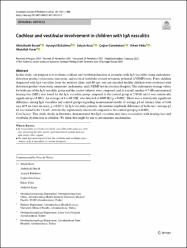Cochlear and vestibular involvement in children with IgA vasculitis

View/
Access
info:eu-repo/semantics/embargoedAccessDate
07.01.2022Author
Bucak, AbdulkadirBükülmez, Ayşegül
Kuzu, Selçuk
Günebakan, Çağlar
Yıldız, Erkan
Kınar, Abdullah
Metadata
Show full item recordCitation
Bucak, A., Bükülmez, A., Kuzu, S., Günebakan, Ç., Yıldız, E., & Kınar, A. (2022). Cochlear and vestibular involvement in children with IgA vasculitis. European journal of pediatrics, 181(4), 1481-1486.Abstract
In this study, our purpose is to evaluate cochlear and vestibular function in juveniles with IgA vasculitis using audiometry, distortion product otoacoustic emissions, and cervical vestibular evoked myogenic potential (cVEMP) tests. Forty children diagnosed with IgA vasculitis from the pediatry clinic and 40 age- and sex-matched healthy children were evaluated with distortion product otoacoustic emissions, audiometry, and cVEMP test in a tertiary hospital. The audiometry average values for both ears of the IgA vasculitis group and the control subjects were compared, and as a result, median 4.7-dB sensorineural hearing loss (SHL) was found for the IgA vasculitis group compared to the control group at 250 Hz and it was statistically significant (p < 0.001). An average of 6.4-dB SHL was detected at 8000 Hz (p < 0.001). There was a statistically significant difference among IgA vasculitis and control groups regarding measurement results of average p1-n1 latency time of both ears (0.9 ms (ms) increase, p = 0.035). In IgA vasculitis patients, the median amplitude difference of both ears’ average p1 n1 was found to be 5.6 mV, statistically significantly decreased compared to the control group (p = 0.003).
Conclusion: This study, firstly in literature, demonstrated that IgA vasculitis may have association with hearing loss and vestibular dysfunction in children. We think this might be due to autoimmune mechanisms.















